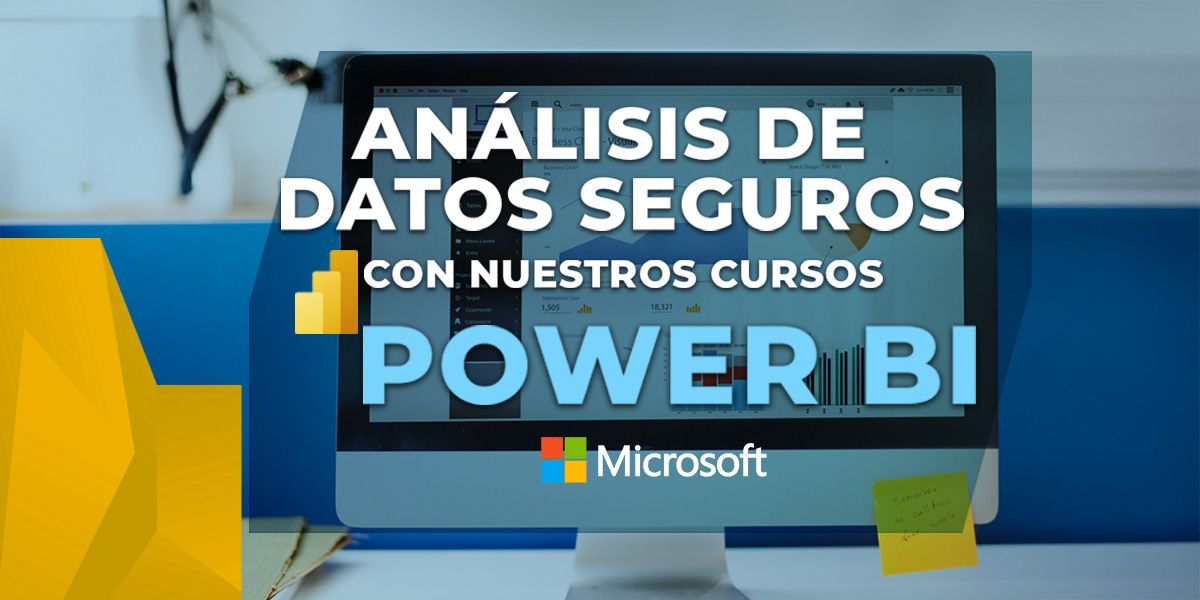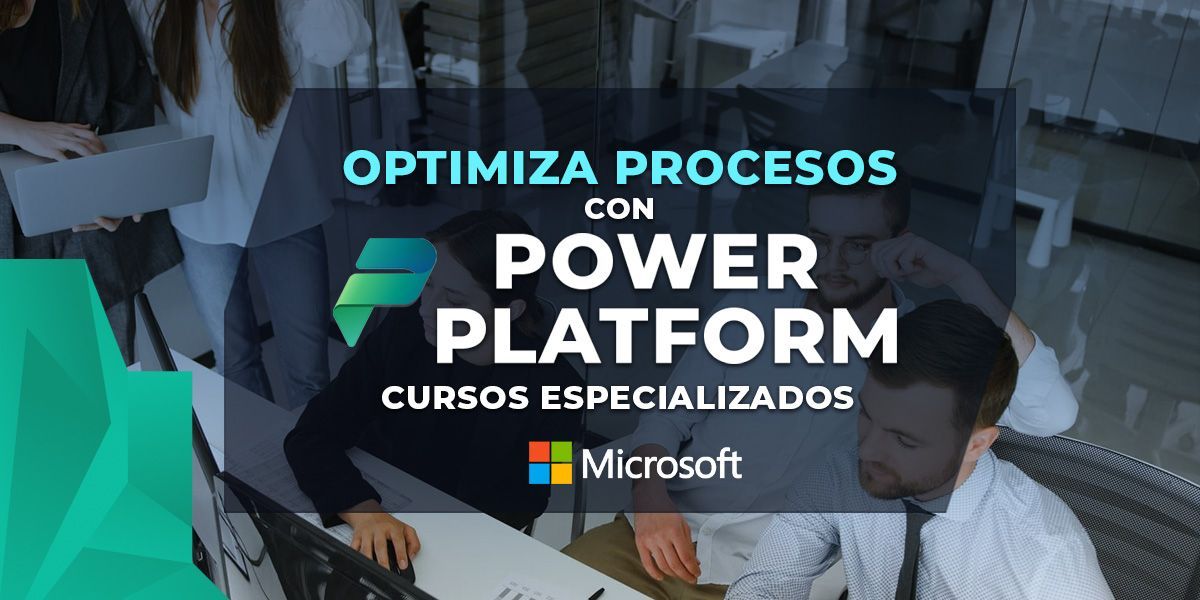Adquiere habilidades inigualables para tu campo laboral y aprovecha
las herramientas que Microsoft tiene para ti
Conoce nuestros cursos de Microsoft Power BI
Designing and Implementing Enterprise-Scale Analytics Solutions Using Microsoft Azure and Microsoft Power BI
Modulo 1: Explore Azure data services for modern analytics
Modulo 2: Understand concepts of data analytics
Modulo 3: Explore data analytics at scale
Modulo 4: Introduction to Microsoft Purview
Modulo 5: Discover trusted data using Microsoft Purview
Modulo 6: Catalog data artifacts by using Microsoft Purview
Modulo 7: Manage Power BI assets by using Microsoft Purview
Modulo 8: Integrate Microsoft Purview and Azure Synapse Analytics
Modulo 9: Introduction to Azure Synapse Analytics
Modulo 10: Use Azure Synapse serverless SQL pool to query files in a data lake
Modulo 11: Analyze data with Apache Spark in Azure Synapse Analytics
Modulo 12: Analyze data in a relational data warehouse
Modulo 13: Choose a Power BI model framework
Modulo 14: Understand scalability in Power BI
Modulo 15: Create and manage scalable Power BI dataflows
Modulo 16: Create Power BI model relationships
Modulo 17: Use DAX time intelligence functions in Power BI Desktop models
Modulo 18: Create calculation groups
Modulo 19: Enforce Power BI model security
Modulo 20: Use tools to optimize Power BI performance
Modulo 21: Understand advanced data visualization concepts
Modulo 22: Monitor data in real-time with Power BI
Modulo 23: Create paginated reports
Modulo 24: Provide governance in a Power BI environment
Modulo 25: Monitor and audit usage
Modulo 26: Broaden the reach of Power BI
Modulo 27: Build reports using Power BI within Azure Synapse Analytics
Modulo 28: Design a Power BI application lifecycle management strategy
Modulo 29: Create and manage a Power BI deployment pipeline
Modulo 30: Create and manage Power BI assets
Analyzing Data with Microsoft Power BI
Modulo 1: Discover data analysis
Modulo 2: Get started building with Power BI
Modulo 3: Get data in Power BI
Modulo 4: Clean, transform, and load data in Power BI
Modulo 5: Design a semantic model in Power BI
Modulo 6: Add measures to Power BI Desktop models
Modulo 7: Add calculated tables and columns to Power BI Desktop models
Modulo 8: Use DAX time intelligence functions in Power BI Desktop models
Modulo 9: Optimize a model for performance in Power BI
Modulo 10: Design Power BI reports
Modulo 11: Configure Power BI report filters
Modulo 12: Enhance Power BI report designs for the user experience
Modulo 13: Perform analytics in Power BI
Modulo 14: Create and manage workspaces in Power BI
Modulo 15: Manage semantic models in Power BI
Modulo 16: Create dashboards in Power BI
Modulo 17: Implement row-level security
Conoce nuestros cursos de Microsoft Azure
Develop Generative AI Solutions with Azure OpenAI Service
Modulo 1:Introduction to Azure OpenAI Service
Modulo 2: Get started with Azure OpenAI Service
Modulo 3: Build natural language solutions with Azure OpenAI Service
Modulo 4: Apply prompt engineering with Azure OpenAI Service
Designing and Implementing a Microsoft Azure AI Solution
Modulo 1: Prepare to develop AI solutions on Azure
Modulo 2: Create and consume Azure AI services
Modulo 3 : Secure Azure AI services
Modulo 4: Monitor Azure AI services
Modulo 5 : Deploy Azure AI services in containers
Modulo 6: Analyze images
Modulo 7 : Classify images
Modulo 9 : Read Text in images and documents with the Azure AI Vision Service
Modulo 10: Analyze video
Modulo 11 : Analyze text with Azure AI Language
Modulo 12: Build a question answering solution
Modulo 13 : Build a conversational language understanding model
Modulo 14: Create a custom text classification solution
Modulo 15 : Create a custom named entity extraction solution
Modulo 16: Translate text with Azure AI Translator service
Modulo 17 : Create speech-enabled apps with Azure AI services
Modulo 18: Translate speech with the Azure AI Speech service
Modulo 19 : Create an Azure AI Search solution
Modulo 20: Create a custom skill for Azure AI Search
Modulo 21 : Create a knowledge store with Azure AI Search
Modulo 22: Plan an Azure AI Document Intelligence solution
Modulo 23 : Use prebuilt Azure AI Document Intelligence models
Modulo 24: Extract data from forms with Azure Document Intelligence
Modulo 25 : Get started with Azure OpenAI Service
Modulo 26: Build natural language solutions with Azure OpenAI Service
Modulo 27 : Apply prompt engineering with Azure OpenAI Service
Modulo 28: Generate code with Azure OpenAI Service
Modulo 29 : Generate images with Azure OpenAI Service
Modulo 30: Use your own data with Azure OpenAI Service
Modulo 31 : Fundamentals of Responsible Generative AI
Microsoft Azure AI Fundamentals
Este curso presenta conceptos fundamentales relacionados con la inteligencia artificial (IA) y los servicios en Microsoft Azure que se pueden usar para crear soluciones de IA. El curso no está diseñado para enseñar a los estudiantes a convertirse en científicos de datos profesionales o desarrolladores de software, sino más bien para crear conciencia sobre las cargas de trabajo comunes de IA y la capacidad de identificar servicios de Azure para apoyarlas. El curso está diseñado como una experiencia de aprendizaje combinada que mezcla capacitación dirigida por un instructor con materiales en línea en la plataforma Microsoft Learn (https://azure.com/learn). Los ejercicios prácticos del curso se basan en módulos de Learn, y se anima a los estudiantes a utilizar el contenido de Learn como materiales de referencia para reforzar lo que aprenden en clase y para explorar los temas con mayor profundidad.
Microsoft Azure Administrator
Modulo 1: Configure Microsoft Entra ID
Modulo 2: Configure user and group accounts
Modulo 3 : Configure subscriptions
Modulo 4: Configure Azure Policy
Modulo 5 : Configure role-based access control
Modulo 6: Configure Azure resources with tools
Modulo 7 : Use Azure Resource Manager Modulo 8: Configure Azure resources with tools
Modulo 9 : Configure virtual networks Modulo 10: Configure network security groups
Modulo 11 : Configure Azure DNS Modulo 12: Configure Azure Virtual Network peering
Modulo 13 : Configure network routing and endpoints
Modulo 14: Configure Azure Load Balancer
Modulo 15 : Configure Azure Application Gateway
Modulo 16: Configure storage accounts
Modulo 17 : Configure Azure Blob Storage
Modulo 18: Configure Azure Storage security
Modulo 19 : Configure Azure Files and Azure File Sync
Modulo 20: Configure Azure Storage with tools
Modulo 21 : Configure virtual machines
Modulo 22: Configure virtual machine availability
Modulo 23 : Configure Azure App Service plans
Modulo 24: Configure Azure App Service
Modulo 25 : Configure Azure Container Instances
Modulo 26: Configure virtual machine availability
Modulo 27 : Configure virtual machine backups
Modulo 28: Configure Azure Monitor
Modulo 29 : Configure Azure alerts
Modulo 30: Configure Log Analytics
Modulo 31 : Configure Network Watcher
Planning and Administering Microsoft Azure for SAP Workloads
Modulo 1: Explore Azure for SAP workloads
Modulo 2: Discover common terms and meanings for SAP on Azure
Modulo 3 : Identify SAP-certified configurations
Modulo 4: Examine SAP NetWeaver with AnyDB on Azure virtual machines
Modulo 5 : Examine SAP S/4HANA on Azure virtual machines
Modulo 6: Explore Azure for SAP compute
Modulo 7 : Explore Azure for SAP networking
Modulo 8: Explore Azure for SAP storage
Modulo 9 : Explore Azure for SAP databases
Modulo 10: Explore identity services for SAP on Azure
Modulo 11 : Explore remote management for SAP on Azure
Modulo 12: Explore governance and manageability for SAP on Azure
Modulo 13 : Deploy single-instance implementations of SAP on Azure (2-tier and 3-tier)
Modulo 14: Implement high availability in SAP NetWeaver with AnyDB on Azure virtual machines
Modulo 15 : Implement high availability for SAP workloads in Azure
Modulo 16: Implement disaster recovery for SAP workloads in Azure
Modulo 17 : Perform backups and restores for SAP workloads on Azure
Modulo 18: Use the planning and deployment checklist for SAP workloads on Azure
Modulo 19 : Explore migration options for SAP on Azure
Modulo 20: Migrate very large databases (VLDB) to Azure for SAP
Modulo 21 : Explore monitoring requirements of Azure for SAP workloads
Modulo 22: Configure the Azure Enhanced Monitoring Extension for SAP
Modulo 23 : Explore licensing, pricing, and support for SAP on Azure virtual machines
Configuring and operating Windows Virtual Desktop on Microsoft Azure
Modulo 1: Azure Virtual Desktop Architecture
Modulo 2: Design the Azure Virtual Desktop architecture
Modulo 3 : Design for user identities and profiles
Modulo 4: Implement and manage networking for Azure Virtual Desktop
Modulo 5 : Implement and manage storage for Azure Virtual Desktop
Modulo 6: Create and configure host pools and session hosts for Azure Virtual Desktop
Modulo 7 : Create and manage session host image for Azure Virtual Desktop
Modulo 8: Manage access for Azure Virtual Desktop
Modulo 9 : Manage security for Azure Virtual Desktop
Modulo 10: Implement and manage FSLogix
Modulo 11 : Configure user experience settings
Modulo 12: Install and configure apps on a session host
Modulo 11 : Configure user experience settings
Modulo 12: Install and configure apps on a session host
Modulo 15 : Monitor and manage performance and health
Developing Solutions for Microsoft Azure
Modulo 1: Azure Virtual Desktop Architecture
Modulo 2: Design the Azure Virtual Desktop architecture
Modulo 3 : Design for user identities and profiles
Modulo 4: Implement and manage networking for Azure Virtual Desktop
Modulo 5 : Implement and manage storage for Azure Virtual Desktop
Modulo 6: Create and configure host pools and session hosts for Azure Virtual Desktop
Modulo 7 : Create and manage session host image for Azure Virtual Desktop
Modulo 8: Manage access for Azure Virtual Desktop
Modulo 9 : Manage security for Azure Virtual Desktop
Modulo 10: Implement and manage FSLogix
Modulo 11 : Configure user experience settings
Modulo 12: Install and configure apps on a session host
Modulo 11 : Configure user experience settings
Modulo 12: Install and configure apps on a session host
Modulo 15 : Monitor and manage performance and health
Developing Solutions for Microsoft Azure
1. Explorar Azure App Service
2. Configurar aplicaciones web
3. Escalado de aplicaciones en Azure App Service
4. Exploración de ranuras de implementación de Azure App Service
5. Exploración de Azure Functions
6. Desarrollo de Azure Functions
7. Exploración de Azure Blob Storage
8. Administración del ciclo de vida de Azure Blob Storage
9. Trabajo con Azure Blob Storage
10. Exploración de Azure Cosmos DB
11. Trabajo con Azure Cosmos DB
12. Administración de imágenes de contenedor en Azure Container Registry
13. Ejecución de imágenes de contenedor en Azure Container Instances
14. Implementación de Azure Container Apps
15. Exploración de la plataforma de identidad de Microsoft
16. Implementación de la autenticación mediante la biblioteca de autenticación de Microsoft
17. Implementación de firmas de acceso compartido
18. Exploración de Microsoft Graph
19. Implementación de Azure Key Vault
20. Implementación de identidades administradas
21. Implementación de Azure App Configuration
22. Exploración de API Management
23. Exploración de Azure Event Grid
24. Exploración de Azure Event Hubs
25. Colas de mensajes de Azure
26. Supervisión del rendimiento de la aplicación
27. Desarrollo para Azure Cache for Redis
28. Desarrollo de almacenamiento en CDN
Designing Microsoft Azure Infrastructure Solutions
Modulo 1: Design governance
Modulo 2: Design an Azure compute solution
Modulo 3 : Design a data storage solution for non-relational data
Modulo 4: Design a data storage solution for relational data
Modulo 5 : Design data integration
Modulo 6: Design an application architecture
Modulo 7 : Design authentication and authorization solutions
Modulo 8: Configure Azure resources with tools
Modulo 9 : Design network solutions
Modulo 10: Design a solution for backup and disaster recovery
Modulo 11 : Design migrations
Designing and Implementing Microsoft Azure Networking Solutions
Modulo 1: Introduction to DevOps
Modulo 2: Design and implement hybrid networking
Modulo 3 : Design and implement Azure ExpressRoute
Modulo 4: Load balance non-HTTP(S) traffic in Azure
Modulo 5 : Load balance HTTP(S) traffic in Azure
Modulo 6: Design and implement network security
Modulo 7 : Design and implement private access to Azure Services
Modulo 8: Design and implement network monitoring
Azure Fundamentals
Modulo 1: Describe cloud computing
Modulo 2: Describe the benefits of using cloud services
Modulo 3 : Describe cloud service types
Modulo 4: Describe the core architectural components of Azure
Modulo 5 : Describe Azure compute and networking services
Modulo 6: Describe Azure storage services
Modulo 7 : Describe Azure identity, access, and security
Modulo 8: Describe cost management in Azure
Modulo 9 : Describe features and tools in Azure for governance and compliance
Modulo 10: Describe features and tools for managing and deploying Azure resources
Modulo 11 : Describe monitoring tools in Azure
Designing and Implementing a Data Science Solution on Azure
Modulo 1: Design a data ingestion strategy for machine learning projects
Modulo 2: Design a machine learning model training solution
Modulo 3 : Design a model deployment solution
Modulo 4: Design a machine learning operations solution
Modulo 5 : Explore Azure Machine Learning workspace resources and assets
Modulo 6: Explore developer tools for workspace interaction
Modulo 7 : Make data available in Azure Machine Learning
Modulo 8: Work with compute targets in Azure Machine Learning
Modulo 9 : Work with environments in Azure Machine Learning
Modulo 10: Find the best classification model with Automated Machine Learning
Data Engineering on Microsoft Azure
Modulo 1: Introduction to data engineering on Azure
Modulo 2: Introduction to Azure Data Lake Storage Gen2
Modulo 3 : Introduction to Azure Synapse Analytics
Modulo 4: Use Azure Synapse serverless SQL pool to query files in a data lake
Modulo 5 : Use Azure Synapse serverless SQL pools to transform data in a data lake
Modulo 6: Explore developer tools for workspace interaction
Modulo 7 : Analyze data with Apache Spark in Azure Synapse Analytics
Modulo 8: Transform data with Spark in Azure Synapse AnalyticsModulo 9 : Use Delta Lake in Azure Synapse Analytics
Modulo 10: Analyze data in a relational data warehouse
Modulo 11 : Load data into a relational data warehouse
Modulo 12: Build a data pipeline in Azure Synapse Analytics
Modulo 13 : Use Spark Notebooks in an Azure Synapse Pipeline
Modulo 14: Plan hybrid transactional and analytical processing using Azure Synapse Analytics
Modulo 15 : Implement Azure Synapse Link with Azure Cosmos DB
Modulo 16: Implement Azure Synapse Link for SQL
Modulo 17 : Get started with Azure Stream Analytics
Modulo 18: Ingest streaming data using Azure Stream Analytics and Azure Synapse Analytics
Modulo 19 : Visualize real-time data with Azure Stream Analytics and Power BI
Modulo 20: Introduction to Microsoft Purview
Modulo 21 : Integrate Microsoft Purview and Azure Synapse Analytics
Modulo 22: Explore Azure Databricks Notebooks with Azure Data Factory
Administering Relational Databases on Microsoft Azure
Modulo 1: Prepare to maintain SQL databases on Azure
Modulo 2: Deploy IaaS solutions with Azure SQL
Modulo 3: Deploy PaaS solutions with Azure SQL
Modulo 4: Evaluate strategies for migrating to Azure SQL
Modulo 5: Migrate SQL Server workloads to Azure SQL Database
Modulo 6: Migrate SQL Server workloads to Azure SQL Managed Instance
Modulo 7: Configure database authentication and authorization
Modulo 8: Protect data in-transit and at rest
Modulo 9: Implement compliance controls for sensitive data
Modulo 10: Describe performance monitoring
Modulo 11: Configure SQL Server resources for optimal performance
Modulo 12: Configure databases for optimal performance
Modulo 13: Explore query performance optimization
Modulo 14: Evaluate performance improvements
Modulo 15: Explore performance-based design
Modulo 16: Automate deployment of database resources
Modulo 17: Create and manage SQL Agent jobs
Modulo 18: Configure Azure Storage security
Modulo 19: Describe high availability and disaster recovery strategies
Modulo 20: Explore IaaS and PaaS solutions for high availability and disaster recovery
Modulo 21: Back up and restore databases
Designing and Implementing Cloud-Native Applications Using Microsoft Azure
Modulo 1: Introduction to Azure Cosmos DB for NoSQL
Modulo 2: Try Azure Cosmos DB for NoSQL
Modulo 3: Plan Resource Requirements
Modulo 4: Configure Azure Cosmos DB for NoSQL database and containers
Modulo 5: Move data into and out of Azure Cosmos DB for NoSQL
Modulo 6: Use the Azure Cosmos DB for NoSQL SDK
Modulo 7: Configure the Azure Cosmos DB for NoSQL SDK
Modulo 8: Implement Azure Cosmos DB for NoSQL point operations
Modulo 9: Query the Azure Cosmos DB for NoSQL
Modulo 10: Configure Azure Virtual Network peering
Modulo 11: Define indexes in Azure Cosmos DB for NoSQL
Modulo 12: Customize indexes in Azure Cosmos DB for NoSQL
Modulo 13: Consume an Azure Cosmos DB for NoSQL change feed using the SDK
Modulo 14: Handle events with Azure Functions and Azure Cosmos DB for NoSQL change feed
Modulo 15: Search Azure Cosmos DB for NoSQL data with Azure Cognitive Search
Modulo 16: Implement a non-relational data model
Modulo 17: Design a data partitioning strategy
Modulo 18: Configure replication and manage failovers in Azure Cosmos DB
Modulo 19: Use consistency models in Azure Cosmos DB for NoSQL
Modulo 20: Configure multi-region write in Azure Cosmos DB for NoSQL
Modulo 21: Customize an indexing policy in Azure Cosmos DB for NoSQL
Modulo 22: Measure index performance in Azure Cosmos DB for NoSQL
Modulo 23: Implement integrated cache in Azure Cosmos DB for NoSQL
Modulo 24: Measure performance in Azure Cosmos DB for NoSQL
Modulo 25: Monitor responses and events in Azure Cosmos DB for NoSQL
Modulo 26: Implement backup and restore for Azure Cosmos DB for NoSQL
Modulo 27: Implement security in Azure Cosmos DB for NoSQL
Modulo 28: Write management scripts for Azure Cosmos DB for NoSQL
Modulo 29: Create resource template for Azure Cosmos DB for NoSQL
Modulo 30: Build multi-item transactions with the Azure Cosmos DB for NoSQL
Modulo 31: Expand query and transaction functionality in Azure Cosmos DB for NoSQL
Designing and Implementing Enterprise-Scale Analytics Solutions Using Microsoft Azure and Microsoft Power BI
Modulo 1: Explore Azure data services for modern analytics
Modulo 2: Understand concepts of data analytics
Modulo 3: Explore data analytics at scale
Modulo 4: Introduction to Microsoft Purview
Modulo 5: Discover trusted data using Microsoft Purview
Modulo 6: Catalog data artifacts by using Microsoft Purview
Modulo 7: Manage Power BI assets by using Microsoft Purview
Modulo 8: Integrate Microsoft Purview and Azure Synapse Analytics
Modulo 9: Introduction to Azure Synapse Analytics
Modulo 10: Use Azure Synapse serverless SQL pool to query files in a data lake
Modulo 11: Analyze data with Apache Spark in Azure Synapse Analytics
Modulo 12: Analyze data in a relational data warehouse
Modulo 13: Choose a Power BI model framework
Modulo 14: Understand scalability in Power BI
Modulo 15: Create and manage scalable Power BI dataflows
Modulo 16: Create Power BI model relationships
Modulo 17: Use DAX time intelligence functions in Power BI Desktop models
Modulo 18: Create calculation groups
Modulo 19: Enforce Power BI model security
Modulo 20: Use tools to optimize Power BI performance
Modulo 21: Understand advanced data visualization concepts
Modulo 22: Monitor data in real-time with Power BI
Modulo 23: Create paginated reports
Modulo 24: Provide governance in a Power BI environment
Modulo 25: Monitor and audit usage
Modulo 26: Broaden the reach of Power BI
Modulo 27: Build reports using Power BI within Azure Synapse Analytics
Modulo 28: Design a Power BI application lifecycle management strategy
Modulo 29: Create and manage a Power BI deployment pipeline
Modulo 30: Create and manage Power BI assets
Microsoft Azure Data Fundamentals
Modulo 1: Explore core data concepts
Modulo 2: Explore data roles and services
Modulo 3: Explore fundamental relational data concepts
Modulo 4: Explore relational database services in Azure
Modulo 5: Explore Azure Storage for non-relational data
Modulo 6: Explore fundamentals of Azure Cosmos DB
Modulo 7: Explore fundamentals of large-scale analytics
Modulo 8: Explore fundamentals of real-time analytics
Modulo 9: Explore fundamentals of data visualization
Azure Security Technologies
Modulo 1: Manage identities in Microsoft Entra ID
Modulo 2: Manage authentication by using Microsoft Entra ID
Modulo 3 : Manage authorization by using Microsoft Entra ID
Modulo 4: Manage application access in Microsoft Entra ID
Modulo 5 : Plan and implement security for virtual networks
Modulo 6: Plan and implement security for private access to Azure resources
Modulo 7: Plan and implement security for public access to Azure resources
Modulo 8: Plan and implement advanced security for compute
Modulo 9 : Plan and implement security for storage
Modulo 10: Plan and implement security for Azure SQL Database and Azure SQL Managed Instance
Modulo 11 : Plan, implement, and manage governance for security
Modulo 12: Manage security posture by using Microsoft Defender for Cloud
Modulo 13 : Configure and manage threat protection by using Microsoft Defender for Cloud
Modulo 14: Configure Azure Load Balancer
Conoce nuestros cursos de Microsoft Power Plataform
Taller: Copilot con Power Platform
Microsoft 365 Copilot
• ¿Qué es y cómo funciona?
• Ventajas que ofrece
• Ejemplos de cómo Copilot puede asistir a las empresas en la creación de código, corrección de errores, optimización de rendimiento, documentación y colaboración.
Power Platform
• ¿Qué es y cómo funciona?
• Ejemplos de como PowerPlatform puede asistir a las empresas sin necesidad de tener conocimientos avanzados de programación en:
• o Creación de aplicaciones con PowerApps.
• Flujos de trabajo con PowerAutomate,.
• Creación de paneles en PowerBI
• Personalzación de páginas web públicas con PowerPage
• Uso de chatbots con Power Virtual Agents
Integración de Microsoft 365 Copilot y PowerPlatform
• Aprender cómo Copilot y PowerPlatform se complementan e integran para crear soluciones inteligentes y escalables para su empresa.
• Ejemplos prácticos para:
• Power Apps
• Power Automate
• Power BI
• Power Virtual Agents
• Power Pages
• Casos de uso:
• Cómo usar Power Automate para automatizar tareas y flujos de trabajo en Teams que involucren datos, notificaciones y aprobaciones
• Cómo usar Power Apps para crear y personalizar aplicaciones en Teams que se adapten a los procesos y escenarios de la organización
• Cómo usar Power BI para visualizar y analizar datos en Teams que permitan tomar mejores decisione
Microsoft Power Platform Functional Consultant
Modulo 1: Describe the business value of the Microsoft Power Platform
Modulo 2: Identify foundational components of Microsoft Power Platform
Modulo 3: Create and manage environments in Dataverse
Modulo 4: Create tables in Dataverse
Modulo 5: Create and manage columns within a table in Dataverse
Modulo 6: Working with choices in Dataverse
Modulo 7: Create a relationship between tables in Dataverse
Modulo 8: Create and define calculation or rollup columns in Dataverse
Modulo 9: Load/export data and create data views in Dataverse
Modulo 10: Get started with security roles in Dataverse
Modulo 11: Use administration options for Dataverse
Modulo 12: How to build your first model-driven app with Dataverse
Modulo 13: Get started with model-driven apps in Power Apps
Modulo 14: Configure forms, charts, and dashboards in model-driven apps
Modulo 15: Use specialized components in a model-driven form
Modulo 16: Customize the command bar
Modulo 17: Get started with Power Apps canvas apps
Modulo 18: Customize a canvas app in Power Apps
Modulo 19: Navigation in a canvas app in Power Apps
Modulo 20: Create formulas to change behaviors in a Power Apps canvas app
Modulo 21: Connect to other data in a Power Apps canvas app
Modulo 22: Introduction to Power Apps cards
Modulo 23: Core components of Power Pages
Modulo 24: Access Dataverse in Power Pages websites
Modulo 25: Explore Power Pages design studio
Modulo 26: Integrate Power Pages websites with Dataverse
Modulo 27: Integrate Power Pages with web-based technologies
Modulo 28: Explore Power Pages design studio data and security features
Modulo 29: Set up Power Pages security
Modulo 30: Authentication and user management in Power Pages
Modulo 31: Best practices for error handling in Power Automate flows
Modulo 32: Use Dataverse triggers and actions in Power Automate
Modulo 33: Introduction to expressions in Power Automate
Modulo 34: Define and create business rules in Dataverse
Modulo 35: Set up low-code plug-ins
Modulo 36: Use common low-code plug-in scenarios
Modulo 37: Get started building with Power BI
Modulo 38: Introduction to solutions for Microsoft Power Platform
Modulo 39: Use Microsoft 365 services with model-driven apps and Microsoft Dataverse
Modulo 40: Use Microsoft Word and Excel templates with Dataverse
Modulo 41: Challenge project - Build applications and automation solutions
Microsoft Power Platform Developer
Modulo 1: How to build your first model-driven app with Dataverse
Modulo 2: Get started with model-driven apps in Power Apps
Modulo 3: Manage tables in Dataverse
Modulo 4: Create and manage columns within a table in Dataverse
Modulo 5: Working with choices in Dataverse
Modulo 6: Create a relationship between tables in Dataverse
Modulo 7: Define and create business rules in Dataverse
Modulo 8: Create and define calculation or rollup columns in Dataverse
Modulo 9: Get started with security roles in Dataverse
Modulo 10: Get started with Power Apps canvas apps
Modulo 11: Customize a canvas app in Power Apps
Modulo 12: Manage apps in Power Apps
Modulo 13: Navigation in a canvas app in Power Apps
Modulo 14: How to build the User Interface in a canvas app in Power Apps
Modulo 15: Use and understand Controls in a canvas app in Power Apps
Modulo 16: Document and test your Power Apps application
Modulo 17: Use imperative development techniques for canvas apps in Power Apps
Modulo 18: Create formulas that use tables, records, and collections in a canvas app in Power Apps
Modulo 19: Perform custom updates in a Power Apps canvas app
Modulo 20: Complete testing and performance checks in a Power Apps canvas app
Modulo 21: Work with relational data in a Power Apps canvas app
Modulo 22: Work with data source limits (delegation limits) in a Power Apps canvas app
Modulo 23: Connect to other data in a Power Apps canvas app
Modulo 24: Use custom connectors in a Power Apps canvas app
Modulo 25: Get started with Power Automate
Modulo 26: Build approval flows with Power Automate
Modulo 27: Introduction to expressions in Power Automate
Modulo 28: Introduction to Microsoft Power Platform developer resources
Modulo 29: Use developer tools to extend Power Platform
Modulo 30: Introduction to extending Power Platform
Modulo 31: Introduction to Dataverse for developers
Modulo 32: Extend plug-ins in Power Platform
Modulo 33: Perform common actions with client script in Power Platform
Modulo 34: Automate business process flows with client script
Modulo 35: Get started with Power Apps component framework
Modulo 36: Build a Power Apps component
Modulo 37: Use advanced features with Power Apps component framework
Modulo 38: Access Dataverse in Power Pages websites
Modulo 39: Extend Power Pages websites
Modulo 40: Build custom Power Pages web templates
Modulo 41: Work with Dataverse Web API
Modulo 42: Integrate Dataverse Azure solutions
Power Platform Solution Architect
Modulo 1: Becoming a solution architect for Dynamics 365 and Microsoft Power Platform
Modulo 2: Discover customer needs as a Solution Architect for Dynamics 365 and Microsoft Power Platform
Modulo 3: Propose a solution as a Solution Architect for Microsoft Power Platform and Dynamics 365
Modulo 4: Work with requirements for Microsoft Power Platform and Dynamics 365
Modulo 5: Perform fit gap analysis
Modulo 6: Implement project governance for Power Platform and Dynamics 365
Modulo 7: Power Platform architecture
Modulo 8: Model data for Power Platform solutions
Modulo 9: Evaluate Power Platform analytics and AI
Modulo 10: Explore Power Apps architecture
Modulo 11: Plan application lifecycle management for Power Platform
Modulo 12: Explore Power Automate architecture
Modulo 13: Model security for Power Platform solutions
Modulo 14: Implement integrations with Power Platform
Modulo 15: Explore Microsoft Copilot Studio
Modulo 16: Explore robotic process automation
Modulo 17: Testing and go-live
Microsoft Power Platform Fundamentals
Modulo 1: Describe the business value of the Microsoft Power Platform
Modulo 2: Identify foundational components of Microsoft Power Platform
Modulo 3: Describe how to build applications with Microsoft Power Apps
Modulo 4: Describe building automation with Microsoft Power Automate
Modulo 5: Describe the capabilities of Microsoft Power BI
Modulo 6: Demonstrate the capabilities of Microsoft Power Pages
Modulo 7: Describe the AI authoring experience in Power Platform
Promociones


Fechas con 50%
PL-300 Analyzing Data with Microsoft Power BI
21hrs / 3 dias
Del 17 al 19 de Diciembre de 8am a 3pm
Precio de Lista $10,000
Precio promocion Buen fin $5,000
AZ-900 Azure Fundamentals
8hrs / 1 dia
1 de Diciembre de 8am a 3pm
Precio de Lista $3600
Precio Promocion $1,800
Vigencia de Promoción: hasta el 28 de Noviembre de 2025

Fechas con el 30%
Taller: Copilot con Power Platform
28hrs / 4 dias
Fecha: del 25 al 28 de NOv de 8am a 3pm
Precio de Lista $10,100
Precio Promocion $ 7,070
Excel Avanzado
15hrs/ 3 Sabados
Fecha :Sabados del 29 de Nov al 13 de Dic de 9am a 1pm
Precio de Lista $2,990
Precio Promocion $2,093
Vigencia de la Promoción: hasta el 28 de noviembre 2025

Fechas con el 20%
55284 Introduction to Python
28hrs / 4 dias
Fecha:: Del 25 al 28 de Nov de 8am a 3pm
Precio de Lista $12,500
Precio Promocion $10,000
Ciencia y Analisis de Datos con Python
20hrs / 5 doas
Fecha: del 15 al 19 de Diciembre de 8am a 12pm
Precio de Lista $15,000
Precio Promocion $12,000
Vigencia de la Promoción: hasta el 28 de noviembre 2025
Nuestra experiencia

+300K
Clientes satisfechos

+150
Instructores certificados

+1,000,000
Horas impartidas
Contáctanos





